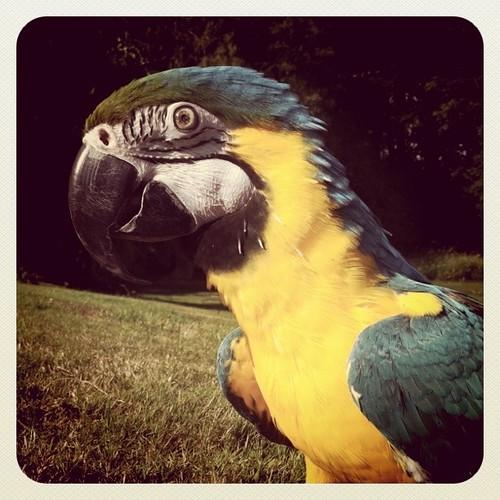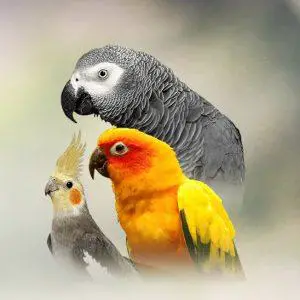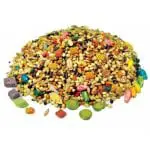Parrots have over 350 species, including lorikeets, macaws, amazons, cockatoos, lovebirds, and more. These birds share similarities despite having differences. All of them possess curved beaks and all of them are zygodactyls. It means they have four toes in each foot. Two-point forward and the other two point backward. They eat fruits, seeds, buds, nuts, and flowers. Some are fed on insects too. Parrots are spread all over the world. Most of them are in South America, Central America, and Australasia.
Many of these parrots are kept by many people as pets. They are considered as great and popular companions for their intelligence, color, and charisma. Some have the ability to mimic sounds like human speech.
Did You Know?
Parrots make use of their body to express what they are feeling. How well do you know about what these actions tell? Here are the meanings of your bird’s behavior. It is important for you to know and understand.
Body Parts
Tail
Tail wagging back and forth after fluffing the feather is a sign of greeting. It means your parrot is happy to see you. Apart from that, it also means that your parrot finished an activity and is ready to start another. Many of them do this as a way to rearrange their feathers too. Cockatoos do this if they are about to eliminate.
- Tail Flaring
The tail feathers fan out. Some species fan their tails in and out. It means the parrot is agitated or excited. In other cases, it means the parrot tends to bite. It is unwise to hold or touch the bird if tail flaring comes with erect posture, nape feathers, and pinpointing eyes.
- Tail Preening

To be in good shape and be clean, parrots spend lots of time to preen. Tail preening is an indication that the bird feels uncomfortable about its surroundings. A nervous parrot doesn’t preen it’s tail or wing feathers, for it cannot give attention to things happening around them.
The preen gland is found above the parrot’s tail. For this reason, they rub their beaks in that spot as they preen. They take some preen oil from their beaks then rub it on their feathers. Some species don’t have preen glands. Pairs preen each other. They preen on their owners too. This means the parrot likes the owner.
Beak
- Beak Grinding
It is a normal action. This is done when they are sleepy or content. It is observed at bedtime. They do this to keep the beak trim and sharp.
- Beak Clicking
Some cockatiels and cockatoos rub the mandible’s top over the bottom one. This doesn’t any indicate a problem, though.
- Beak Wiping
Most parrots rub their beaks on perches. This means they want to get the food off from their beak or keep their beaks polished.
Eyes

- Flashing or Pinning
This is only for parrots having light eyes. Shrinking and iris enlargement mean excitement, surprise, anger, and agitation. Others pin their eyes when they vocalize, play, or eat new or favorite food. However, eye pinning and erect feather nape with tail flaring mean it will bite.
- Eye Contact
They stare at an object to show interest in it. Having direct contact tends to be threating and frightening to a shy or nervous parrot, but a socialized one doesn’t care about this.
- Blinking
If they feel nervous, they don’t blink their eyes when looking at anything that causes them to feel nervous.
Head
Video Source: Youtube
- Head Bobbing
To beg for food or attention or to show excitement. A very excited cockatoo, for example, will bob and sway its head with its crests up.
Feet
- Tapping
Most males do this to show dominance or strength. Others do this to get their owner’s attention.
Wings
Wing stretching means a greeting to the owner and the start of a new activity.
Gestures
- · Chin-up
They want to be petted. They enjoy a neck scratch. Others scratch their heads slowly using their food, which means they want to be petted.
- · Nape Feathers Up
Agitation or territory guarding is what it means. Don’t handle the parrot. Wait for it to calm down, particularly if it struts and pins its eyes.
- · Regurgitation
This shows affection. Regurgitating food from the crop to the owners regards its owner as its mate. Mating birds regurgitate to feed each other. Only the male does this in most cases as a sign of courting. Nesting females are fed by a male through regurgitation. Before they regurgitate, they bob their heads. Moreover, when they like a toy or in front of a mirror, this action is noticed.
- · Panting
The parrot pants when it is tired stressed of overheated. To deal with overheating, put the bird in a cool area. When stressed, move the bird in a place where it can relax. Remember that they can die due to stress.
- · Biting
This is an indication of being frightened, guarding the territory, or controlling the owner. For babies, this is done to explore, or for most parrots, beaks are utilized to make themselves steady as they climb or walk on perches.
- · Jousting
It is a sign of playing among the young parrots, but other sized birds should not be allowed to do this.
- · Feathers Over Beak
For cockatoos that have mobile feathers found under their beaks, they fluff them over the beaks to show contentment and relaxation.
- · Chewing
Inbreeding season, they chew more than usual for the reason that they are cavity breeders and need to hollow out the tree to make a nest. For enjoyment, they chew too. Then, they should be given more chew toys.
- · Flipping
The wings are slapped against the parrot’s body. Babies and adults do beg for food. In contrast, flipping with the erected body means frustration, anger, or annoyance. Don’t touch your bird if it flares and pins its eye.
- · Biting
For babies, beaks are used for exploring and trying things out. It should not be discouraged. Don’t give harsh punishments. Instead, teach step-up to have more control over your bird. Practice it every day. If your parrot nips, do laddering. Make your bid do about six steps up between your hands. The earthquake method is also recommended. Shake your body or arm when it nips you, but don’t let it fall.
Parrot Is Territorial
Parrots tend to guard their owners, play stands, or cages. Teach them to step up on a stick. They become aggressive.
Parrot Does Not Want to Do Something
Some parrots do this to control you. don’t show fear as it will become more aggressive to you. A step-up practice every day should be done.
Fear
A frightened parrot tends to escape; if not, they bite. Yet, never give punishment to a fearful and shy parrot.
Parrot is Overstimulated
This is seen in active parrots. At playtime, a very excited parrot tends to bite since it is overwhelmed. Let it calm down before you pick it.
Feather Picking
This is frustrating for the bird and the owner as well. It is an indication of a disease.
Hormonal Behavior
As seasons change, parrots undergo hormonal changes in their behavior, especially in spring. This is a normal and natural process. Nonetheless, it comes with a challenge. The spring behavior happens to a sexually mature parrot once a year in their life. It is also called the nesting or hormonal behavior. An owner must then be aware and alert. Again, this behavior is enhanced in springtime. As the breeding season comes near, the sexually mature ones undergo natural hormones that cause unusual and bizarre behaviors.
The most affected ones are the female birds who show unusual changes. They may be seen scratching or tearing newspapers in their cage with removing of feathers. It is a natural adjustment, though. Even the birds cannot control this. Owners must then be patient and tolerant as it will soon pass.
This behavior is instinctual. At the beginning of the breeding season, they show attempts of making a nest or searching for materials to make a nest. It gives them the urge to build a nest by any means, like plucking their own feathers. This action is destructive to them and should be constantly checked to find remedies and do necessary actions.
Other behaviors include too much screaming, biting, and bluffing to being too affectionate. It also includes the following:
- Flat backing. This is the female’s submissive behavior to be fed by their favorite person. It can be accompanied with clucking, or wing shivering. Others tend to act like babies.
- Strutting with the tail feathers fanned, the neck feathers up, and the eyes flashing wildly. This is a male behavior when meeting new people. It is normal for territorial behavior.
- Nest-making. This is shown by burrowing in the sofa pillows or fabric. It destroys anything it touches. Males can be very destructive of things.
- Feather picking. Some birds do pick, or feather chews in some parts of their bodies.
What Should You Do?
Although it is frustrating, you cannot do anything to get rid of this, but there are some things you can do to get through.
- Put a mark on your calendar regarding the start and end of this behavior. It will make you prepare for handling your bird’s behavior.
- When your parrot gets aggressive to humans, leave your bird in the cage, but don’t leave it unattended.
- Don’t pet your bird. Restrict petting not to stimulate them further.
- Remove the toy or any object that your bird is obsessed with.
- Clip your bird’s wings since it will regrow.
- Never punish your parrot, for it is not doing anything wrong.
- Understand that this is a natural behavior for them.
- Limit your family members from interacting with your pet.
- Limit the daylight hours in order to mimic the winter sun.
- The vet can prescribe drugs for hormonal balance.
What Triggers Breeding Behavior?
- Extended hours of light. To cause the reproductive organs to increase in terms of size, the days and amount of artificial light are lengthened. This triggers an increase in hormonal activity.
- The availability of a suitable nest site as well as nesting materials. Discourage your parrot from claiming that cardboard boxes are nesting sites.
- Availability of a mate. It can be you, a favorite toy, or an object.
- Diet. levels of protein, fat, and starches, including wet and warm food, encourage breeding behavior.
- Perceived sexual petting like stroking near the vent or bird’s backside.
Conclusion
Let nature take its natural course. Parrots have no choice of this stage in their life. It is the best that the owner has to be there and understand what their pets are going through. However, owners must be on guard for excessive behavior as it may cause serious problems.


